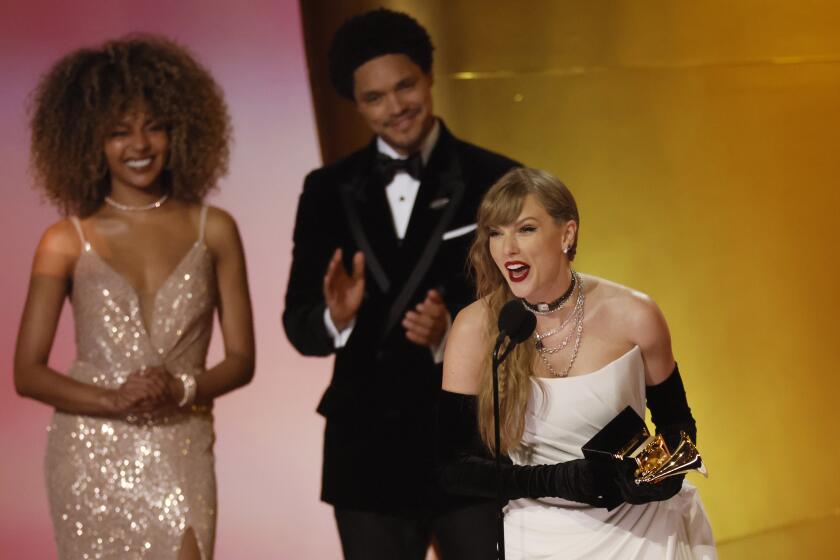Out of his own purple haze
- Share via
In “The Carter,” the documentary about Lil Wayne that premiered at the Sundance Film Festival last month, the superstar rapper is filmed in some compromising positions. Namely, he’s shown taking his medicine.
In one scene, the extravagantly tattooed and dreadlocked rhymesayer pours a viscous purple liquid from a prescription bottle into a soda jug then mixes himself a cocktail, gulping it out of a giant Styrofoam cup. In Southern hip-hop circles this potent narcotic mixture is known as “purp,” “drank” or “sizzurp” -- cough syrup fortified with codeine, hydrocodone and/or promethazine that, if taken at a high enough dosage, can produce a swooning high. One that’s also potentially fatal.
At another moment in the film, the multiplatinum-selling New Orleans MC opens up a Louis Vuitton attache case that travels with him everywhere to reveal a stack of money as thick as a brick and a Glaceau VitaminWater bottle filled with purple fluid. “That ain’t VitaminWater,” Wayne says in the film, laughing at his ruse to smuggle the stuff across international borders.
Filmed between May and September 2008, just as his popularity was hitting critical mass, “The Carter” presents an unexpected slice of life from last year’s top-selling pop artist, who comes into tonight’s Grammys nominated for more awards than any other act. Lil Wayne (a.k.a. Weezy F. Baby, government name: Dwayne Michael Carter Jr.), who will also perform on the show, which will air on CBS beginning at 8 p.m., is up for eight statuettes in categories including album of the year.
But in addition to those revealing scenes, “The Carter” underscores what many of the rapper’s collaborators, career overseers and industry observers already know. In ways both profound and ridiculous, Lil Wayne is defined by his contradictions.
Weezy declined to be interviewed for this story. But at a time when other MCs prematurely have mourned hip-hop’s death and rap sales are down across the board, Lil Wayne remains the genre’s raging id, the guy who called himself “the best rapper alive” until nobody could deny it anymore. A trickster griot with a sneaky intellect and a smoke-rasped voice, he can be viewed as the fruit of hip-hop’s world-beating ambitions as well as the embodiment of the culture’s untamable contrarian streak -- no mean feat considering that the mainstream seems to have crossed over into Lil Wayne’s world rather than vice versa.
As a preamble to selling nearly 3 million copies of his seventh studio CD “Tha Carter III” last year, Lil Wayne first flooded the market with his music, digitally distributing some two dozen albums’ worth of material free. “It’s a simple process. You’ve got to give to get,” said Danyel Smith, editor in chief of Vibe magazine. “Fans feel like, ‘You gave me all this for free. Now I’m going to support you when you actually need me.’ ”
And now, after having outsold everyone on the pop landscape and becoming a Top 40 fixture by contributing his free-associative verses and Auto-Tune crooning on hundreds of other artists’ songs, Lil Wayne, 26, is moving into relatively uncharted territory.
Collaborating with hip-hop-rock fusionist Kevin Rudolf on last year’s smash single “Let It Rock” (which has sold around 2.5 million copies worldwide) has led to Lil Wayne’s next iteration. His album “Rebirth,” slated for release in April, finds the rapper continuing “in a rock vein.” Rudolf recorded two new songs with him and is at work on a third. He couched Weezy’s efforts to recast himself as a rock star in terms usually reserved for Guns N’ Roses’ seminal 1987 album.
“It’s real bad ass. Pure attitude. Real rock ‘n’ roll,” Rudolf said of Wayne’s new music. “That’s where music’s going. What music’s missing. You can’t do it in rock anymore because rock takes itself too seriously. What Wayne’s doing, he’s bringing ‘Appetite for Destruction’ into 2009. That’s what’s really setting him apart.”
--
An early start
Standing just 5 feet 6 and boasting a mouth full of gleaming diamond- and platinum-encrusted teeth, Lil Wayne has grown up in public. And everything from his earliest sexual encounter (credit groupie love) to his protean work ethic has come courtesy of hip-hop.
Raised in New Orleans’ rough-and-tumble 17th Ward, young Dwayne was unofficially adopted around age 13 by that city’s gangsta rapper turned music mogul Bryan “Baby” Williams, co-chief executive of Cash Money Records. Weezy came of age just as Southern rap found widespread national recognition, and he devoted most of his teens to the platinum-selling gangsta rap trio the Hot Boys.
Throughout the early ‘90s, his albums sold millions, though he remained mostly off the mainstream grid. He still was associated closely with the niche Southern rap community, and few outside the Cash Money fold would have predicted Wayne’s maturation into a kind of hip-hop savant who spews off-the-cuff rhymes -- sometimes in French, calling himself a Martian and spanning a crazy quilt of cultural touchstones, including a rebuke of President Bush’s handling of Hurricane Katrina -- like other people write e-mail.
The rapper clearly thrills in onomatopoeia, rhyming “don’t let the devil in” with “heavy metalin’,” “Led Zeppelin,” “estrogen” and “new testament” on the song “I’m Me.”
According to Cash Money’s co-CEO Ronald “Slim” Williams, Wayne’s success has everything to do with the work-hard/no-play ethos his label boss/father figures drilled into him. “Instead of getting caught up with all the things that come with being an artist in the music industry, he stayed focused on being the best,” Williams said. “While everyone was running around partying, he was in the studio, working, practicing his craft.”
Following Weezy for four months as he toured the world last summer, “The Carter” director Adam Bhala Lough captured a portrait of the artist as a young workaholic -- a guy whose rap braggadocio and sexual bluster can’t disguise that his only real solace is creative release. Schlepping a mobile studio in a black bag with him, Lil Wayne is shown laying down vocals wherever he goes: in hotel rooms and tour buses as well as professional recording booths. He writes down nothing, improvising sophisticated rhyme schemes and spitting tightly calibrated pileups of goofy jokes, disses and cultural allusions on the spot.
“It’s breathtaking what comes out of this guy’s mind,” said Lough a day after the movie’s premiere in Sundance. “I wanted to have these long, unedited takes where you’d see Wayne’s raw performance on camera. You can say, ‘He’s just rapping.’ No he’s not! It’s like performance art.”
Added Quincy Jones III, producer of “The Carter”: “You can tell that he’s fearless in terms of trying new things. Having worked with Tupac, [Wayne] reminded me of him in that way. He’s excited about being good and the sales numbers are secondary.”
For his part, Lil Wayne seems intent on not over-intellectualizing his process. “I just record, man,” Wayne says in “The Carter.” “Whenever, wherever. It doesn’t matter. I got thoughts in my head all day, every day. So to get to the studio, it’s a release for me. The [stuff] I got to get it off my mind. Stop thinking about it and stuff.”
Rudolf feels Weezy found his mojo by seizing upon a kind of relentless creativity that’s unique to hip-hop. “It’s fascinating to watch Wayne doing his thing,” Rudolf said. “I respect him as a rapper, an artist, a musician. He’s a leader.”
--
‘Sizzurp’ fatalities
Cough syrup might seem a random drug of choice for anyone unfamiliar with Southern hip-hop culture. But within certain Houston precincts, it is as commonplace as smoking copious weed (something else Lil Wayne is caught doing in “The Carter”). The high you get from syrup -- or “sizzurp,” a la the Three 6 Mafia’s “Sippin’ on Some Sizzurp” -- can be woozily euphoric. It spawned a sub-genre of Texan rap called chopped and screwed in which a song’s tempo and a rapper’s vocal pitch are slowed way down to sonically replicate the soupy fog of a syrup buzz.
Which wouldn’t be much of a problem if so many people in the hip-hop community hadn’t died as a result of complications from sippin’ on sizzurp. Among them: the guy who started the chopped and screwed genre, DJ Screw; Pimp C of the rap group UGK and Houston rapper Big Moe.
As first pointed out by Vibe magazine, Lil Wayne has done little to camouflage his affection for sizzurp, rapping “I’m probably drinkin’ that syrup/Thinking I won’t slip/Even though I’m leaning like a broken hip” in 2005’s “Lock & Load.”
But that lifestyle choice hasn’t come without consequences. In “The Carter,” Lil Wayne’s childhood friend/DJ/manager/president of his Young Money label imprint Cortez Bryant is so upset by the rapper’s affinity for syrup that he refuses to travel on Weezy’s tour bus.
“He knows it’s a sickness,” Bryant says in one scene. “But what it is, deep down, I don’t think he wants to be dead. But it got to that point. It escalated.”
In the documentary, Lil Wayne (shown in a YouTube clip from a concert last January) denies being in the grips of any addiction. “A junkie can’t do what . . . I do,” he says. “I am the ultimate high. I am my drug.”
It’s a strange moment in popular culture when one is forced to consider a first-time Grammy nominee celebrating a potential win not by hoisting a flute of champagne but by chugging purp from a Styrofoam cup. “I’m amazed that Lil Wayne is the darling of the 2009 Grammys,” Vibe’s Smith said. “But his presence and impact are undeniable.”
And yet come April, with “Rebirth,” Wayne risks polarizing his fans with his rock star reboot.
“People will be surprised how good a job he did on this record,” said Cash Money’s Williams. “Some people would be scared to take that chance. You got to have heart to go out in that water and swim with those sharks. He got that heart. He ain’t scared to try nothing.”
--
More to Read
The biggest entertainment stories
Get our big stories about Hollywood, film, television, music, arts, culture and more right in your inbox as soon as they publish.
You may occasionally receive promotional content from the Los Angeles Times.











